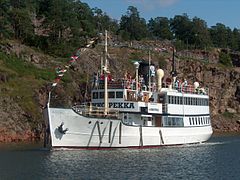
A screw steamer or screw steamship (abbreviated "SS") is an old term for a steamship or steamboat powered by a steam engine, using one or more propellers (also known as screws) to propel it through the water. Such a ship was also known as an "iron screw steam ship".
In the 19th century, this designation was normally used in contradistinction to the paddle steamer, a still earlier form of steamship that was largely, but not entirely, superseded by the screw steamer. [1]
Many famous ships were screw steamers, including the RMS Titanic and RMS Lusitania. These massive leviathans had three or four propellers. Ships under two hundred meters in length usually only had two or one propellers. [2]
Development
Following a number of smaller experimental boats and ships in the mid and late 1830s, the first screw powered ocean-going ship was the British SS Archimedes of 1839, using a propeller designed by Francis Smith based on his 1835 patent.
In 1844, Thomas Clyde partnered with British-based Swedish inventor John Ericsson to apply his screw-propeller to steam vessels. After several experimental versions, Clyde launched the twin-screw propeller steamer John S. McKim making it the first screw steamer built in the United States for commercial use. [3]
See also
- List of ships
- SS Archimedes - the world's first steamship to be driven by a screw propeller
References
- ^ Canney, 1998 pp.11-13
- ^ Canney, 1998 pp.26-27
- ^ Young, John Russell (1898). Memorial History of the City of Philadelphia From Its First Settlement to the Year 1895. New York: New York History Company. pp. 392–394. Retrieved 19 November 2020.
Bibliography
- Canney, Donald L. (1998).
Lincoln's Navy: The Ships, Men and Organization, 1861-65. Naval Institute Press. pp.
232.
ISBN
9781557505194.
screw steamer.
External links
-
 Media related to
Screw steamers at Wikimedia Commons
Media related to
Screw steamers at Wikimedia Commons